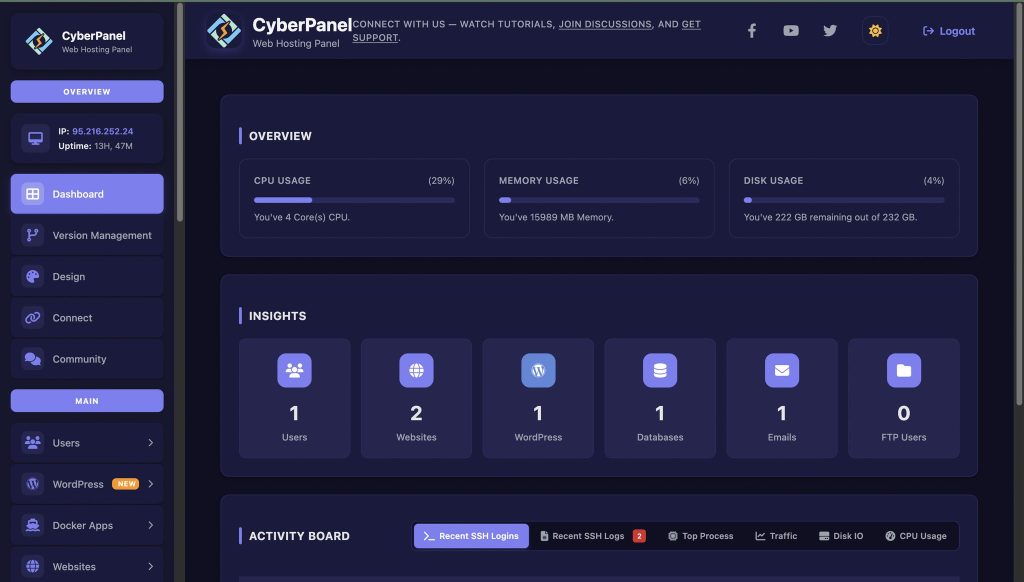PostgreSQL is one of the strongest open-source relational databases. In tandem with Docker, deployment and scalability take on a different dimension. Docker Postgres allows developers and system administrators to quickly create isolated instances of databases without the need to go through the headaches associated with the standard installation process. It doesn’t matter whether you do testing on your computer or do production – work with the database will be simple, scaling and migrating database containers are faster and more effective.
With Docker, Postgres Docker containers can be executed within seconds using pre-built Docker Hub Postgres images. Thus, manual configuration is negated and optimized for a reliable development or production environment. The results are improved portability, better version control, and optimal software resources. The combination of PostgreSQL stable work and Docker flexibility forms a simple but easy-to-manage and stable solution.
In this guide, we will provide detailed information about Postgres Docker images and will tell you how to configure a Postgres Docker container. This guide will also be informative, considering container integration with services, deployment automation, data persistence, and practical issues such as bookmarks..
What is Docker Postgres and Why Use it?
It is running a PostgreSQL database inside a Docker container. It is used to simplify the database configuration process, optimize database service among development and QA, and make indicators faster for the project teams.
How to Set Up a Postgres Docker Container Easily?
A Postgres Docker container can be set up with a single command. After that, Docker pulls the image from the hub, launches the container from it, and opens the container on the port. Here is an example Command:
docker run --name my-postgres -e POSTGRES_PASSWORD=secret -p 5432:5432 -d postgres
Output:
Get exclusive access to all things tech-savvy, and be the first to receive
the latest updates directly in your inbox.
Unable to find image 'postgres:latest' locally
latest: Pulling from library/postgres
Digest: sha256:xxxxxxxxxxxxxxxxxxxxxxxxxxxxx
Status: Downloaded newer image for postgres:latest
xxxxxxxxxxxxxxxxxxxxxxxxxxxxx
This starts a fully functional PostgreSQL server on port 5432.
How to Use a Postgres Docker Image from Docker Hub?
You can pull it directly from Docker Hub Postgres, which hosts official and trusted images.
docker pull postgres
This gives you the latest stable PostgreSQL image that can be used for local development, testing, or production environments.
How to Use Postgres with Docker Compose?
Docker Compose allows you to define multi-container setups. It makes it ideal for applications that require PostgreSQL along with other services like backend APIs.
Example: docker-compose.yml
version: '3.8'
services:
db:
image: postgres
container_name: postgres_db
environment:
- POSTGRES_USER=admin
- POSTGRES_PASSWORD=secret
- POSTGRES_DB=myapp
ports:
- "5432:5432"
volumes:
- pgdata:/var/lib/postgresql/data
volumes:
pgdata:
Run:
docker compose up -d
How to Manage Data Persistence in Postgres Docker?
You can use Docker volumes to persist data. This ensures your data isn’t lost when containers are restarted or removed.
docker volume create pgdata
Attach this volume to your Postgres container to keep your data safe.
How to Connect to Postgres Docker from Your Application?
Applications can connect to Postgres Docker. It uses localhost and the exposed port. For example, in a .env file:
DATABASE_URL=postgres://admin:secret@localhost:5432/myapp
Role of CyberPanel

CyberPanel, a web hosting control panel, integrates with Docker, so deploying and managing containers on CyberPanel (including Postgres) is extremely easy. After logging into the GUI, you can:

- Pull Postgres images from the Docker Hub without needing to use CLI commands.
- Manage multiple Postgres Docker containers in one convenient dashboard.
- See container performance and logs directly from the GUI.
- Restart, remove, or update a container with the click of a button.
For hosting environments powered by CyberPanel, this is an easy way to manage containers when using PostgreSQL and is great for those preferring to avoid the CLI.
Final Thoughts!
In conclusion, Docker Postgres provides a quick and trusted method of deploying a database.
With Docker Postgres, you can deploy a database easily and quickly, and you can scale it as needed. Containers make deploying PostgreSQL for a variety of use cases (testing, production) simple and straightforward. Plus, if you combine it with CyberPanel, you will have the benefit of managing your database through a GUI and also the ease of hosting it on CyberPanel.
Start playing with Postgres in Docker now and enjoy a much faster experience and greater control.
People Also Ask
How do I back up a Postgres container?
You can back up a Postgres container using the pg_dump command or by mounting a volume and exporting data. This ensures your data is safe even if the container is removed.
Can I use Docker Postgres for production databases?
Yes. Docker Postgres can be used in production if you follow best practices like persistent storage, secure environment variables, regular backups, and proper networking configuration.
Is it possible to connect multiple containers to the same Postgres instance?
Yes. By using a custom Docker network, multiple containers can securely communicate with the same Postgres container, making it ideal for microservices.



